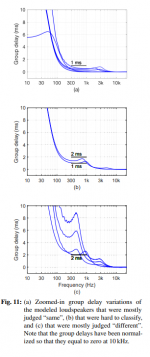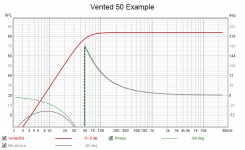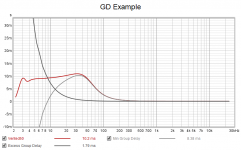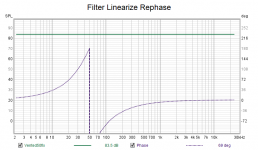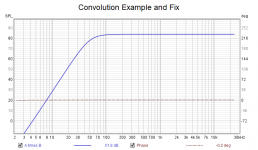. So artistic decisions (levels, EQ, timing) do take that into account.
Ha! Yes artistic decisions. I love that, it’s so true. I’ve purposely misaligned my midbass to subs by 1-3ms before because it just sounded better, had better interaction with the room and sounded better overall. Although that 1-3ms was only a fraction of phase between them, where tape measurement distance wasn’t sounding right. Never thought the recordings were at play into some of it.
Since a BR is acting the same way, there is nothing stopping you of tuning a cabinet with a Q of 0.5 or so.
In that way one can get exactly the same response as a LT sub with an highpass filter.
(Not using any HP filter on LT is kind of stupid and asking for trouble.)
From a control theory point of view, those systems will be 100% identical.
Obviously both systems have their own advantages and disadvantages when it comes down to non-linear behavior as well as practical considerations for different reasons.
But that's inherent to the properties of those systems.
Not sure what you mean here. Transient response is in the magnitude/phase response.
Compared to a sealed alignment BR will reduce driver excursion above the tuning frequency and increase it under it. That is about the only difference that remains once you turn both of them into a given filter using FIR (with a final slope of at least 24dB/oct of course).
You can for example use a BR alignment for a midbass driver, with a high tuning frequency (around crossover frequency) that will result in a large bump in its response. Once you compensate for all this in the FIR to build a crossover with a steep-ish slope (eg 48dB/oct) you end up with a system that behaves exactly like if you had build that same response upon a sealed midbass, but with much lower excursion in the lower range. That typically let you lower the crossover frequency, and/or use a driver with a lower excursion and higher efficiency.
That can be a good trade-off, but is more difficult to build than a sealed system (eg avoiding resonances of the tuning port in the passband), and can also be less "stable" than a sealed system. The higher the Q the more sensitive the response will be to system variations such as temperature (from the room, or from signal in the VC), manufacturing consistency, amplifier output impedance or suspension aging.
Okay that’s making sense..... I would have thought for sure the tight air spring in sealed would play a role in transient behavior. The air and compliance together. With a proper choice in BR and sub Q, I can see what your saying now. I never really thought of it like that, but it’s right there. It seems to me however, after all the corrections, you’ll net a similar output as sealed maybe with a little more efficiency near tuning. But once made flat seems the eq would kill the added gain as you’ll have to align it to the front side of driver. So a bigger box, port noise and resonances and can’t play as low. I’m still not seeing any big advantage to BR besides maybe wanting a lot of output in the 30s.
In your example with a midbass, that seems excellent actually. Especially if fs is right below tuning. That seems an obvious choice if someone wanted to play loud.
Very interesting......definitely didn’t see it like that before thank you
Last edited:
Hi pos,
Thank you, that is fair response.
Hi Oabeieo,
I am still grasping with the concept, so I may not quite understood but, is the idea not to just correct the phase and leave the magnitude intact?
According to my simulations, a BR requires much less power, and thus also an excursion, for an equivalent pre-determined maximum SPL than a closed box.
Kindest regards,
M
It was certainly audible with the right tracks and SPL, but not necessarily subjectively "better". Bass was sometimes "tighter", but then the balance was also different. There is a case to be made that regardless of the speakers used during production (number of ways, crossover frequencies and slopes, etc), virtually none of them are phase linear down low. So artistic decisions (levels, EQ, timing) do take that into account.
Thank you, that is fair response.
Hi Oabeieo,
Oabeieo said:But once made flat seems the eq would kill the added gain as you’ll have to align it to the front side of driver.
I am still grasping with the concept, so I may not quite understood but, is the idea not to just correct the phase and leave the magnitude intact?
Oabeieo said:So a bigger box, port noise and resonances and can’t play as low. I’m still not seeing any big advantage to BR besides maybe wanting a lot of output in the 30s.
According to my simulations, a BR requires much less power, and thus also an excursion, for an equivalent pre-determined maximum SPL than a closed box.
Kindest regards,
M
Last edited:
Iterative REW / RePhase Workflow Method
I don't think I have seen this workflow referenced before, or if I did, I didn't recognize it as such.
FWIW, I stumbled on a REW feature that I was unaware of that can be used in conjunction with RePhase's multiple banks. Instead of measuring, creating a filter, applying the filter, remeasuring and reiterating, the multiple passes can be done in REW without physically remeasuring multiple times.
For example, if one does a single pass 5dB cuts filter off the top, REW will only generate up to 17 coarse PEQs for RePhase (not much detail).
If you try to generate 3 sets of filters from sub-frequency ranges to get more detail (e.g. low, medium, high), REW doesn't handle the aggregated boundary edge transitions very well.
As an alternative, one can make 5 - 1dB cuts filters, each based on its real or predicted predecessor and end up with 5 sets of 17 PEQs (vs 1 set of 17). Each set would get loaded into a respective RePhase bank and combined in a single filter using the minimum-phase setting to adjust both frequency amplitude and phase.
To do this, use REW's EQ function, setup your desired target curve and instead of doing the entire N dB "Match Response to target" cut, do it across multiple passes. Select an incremental cut amount and generate the 1st set of PEQ's and save them using "Save filter settings to file" labeled as "left bank 1".
Then select the "Generate measurement from predicted" option below the "Save filter settings to file" to generate the new "predicted measurement".
Then select the EQ option on the newly generated "predicted measurement", lower the target curve by the chosen incremental amount and repeat the process naming the subsequent filters "left bank 2, left bank 3, ..., left bank N".
You can then load all N-incremental-banks into RePhase and get an aggregate filter more refined versus doing it in a single coarse pass in REW.
If anyone sees any issues with using this workflow method, please speak out. The resulting refined aggregate filter looks as expected when loaded into REW and when applied and measured. It is much faster than doing the manual measure/generate/aggregate repeat method and probably more accurate.
Hope this helps someone get better results.
I don't think I have seen this workflow referenced before, or if I did, I didn't recognize it as such.
FWIW, I stumbled on a REW feature that I was unaware of that can be used in conjunction with RePhase's multiple banks. Instead of measuring, creating a filter, applying the filter, remeasuring and reiterating, the multiple passes can be done in REW without physically remeasuring multiple times.
For example, if one does a single pass 5dB cuts filter off the top, REW will only generate up to 17 coarse PEQs for RePhase (not much detail).
If you try to generate 3 sets of filters from sub-frequency ranges to get more detail (e.g. low, medium, high), REW doesn't handle the aggregated boundary edge transitions very well.
As an alternative, one can make 5 - 1dB cuts filters, each based on its real or predicted predecessor and end up with 5 sets of 17 PEQs (vs 1 set of 17). Each set would get loaded into a respective RePhase bank and combined in a single filter using the minimum-phase setting to adjust both frequency amplitude and phase.
To do this, use REW's EQ function, setup your desired target curve and instead of doing the entire N dB "Match Response to target" cut, do it across multiple passes. Select an incremental cut amount and generate the 1st set of PEQ's and save them using "Save filter settings to file" labeled as "left bank 1".
Then select the "Generate measurement from predicted" option below the "Save filter settings to file" to generate the new "predicted measurement".
Then select the EQ option on the newly generated "predicted measurement", lower the target curve by the chosen incremental amount and repeat the process naming the subsequent filters "left bank 2, left bank 3, ..., left bank N".
You can then load all N-incremental-banks into RePhase and get an aggregate filter more refined versus doing it in a single coarse pass in REW.
If anyone sees any issues with using this workflow method, please speak out. The resulting refined aggregate filter looks as expected when loaded into REW and when applied and measured. It is much faster than doing the manual measure/generate/aggregate repeat method and probably more accurate.
Hope this helps someone get better results.
Last edited:
This might be a case of terminology confusion, transient response for a woofer is normally described in terms of the Q of the low frequency rolloff, which is a magnitude issue.I am still grasping with the concept, so I may not quite understood but, is the idea not to just correct the phase and leave the magnitude intact?
Linearizing phase to remove group delay can also be used to make the output waveform more closely match the input waveform and transient response is often talked about here too.
My experience with modifying phase at low frequencies is that making the phase flat and linear but have the magnitude rolloff is not overall a good choice. As always some tracks benefit but for most it sounds off.
Keeping the minimum phase relationship intact is a better target and by taking the woofer low enough it becomes linear in phase and magnitude low enough.
As above until you get below the tuning frequency and then excursion explodes as the cone is not being controlled anymore. Whether this is a problem or not depends on the use case.According to my simulations, a BR requires much less power, and thus also an excursion, for an equivalent pre-determined maximum SPL than a closed box.
Hi pos,
Thank you, that is fair response.
Hi Oabeieo,
I am still grasping with the concept, so I may not quite understood but, is the idea not to just correct the phase and leave the magnitude intact?
According to my simulations, a BR requires much less power, and thus also an excursion, for an equivalent pre-determined maximum SPL than a closed box.
Kindest regards,
M
Yeah BR is much more efficient as far as the port adds basically double the output. You you are using the front and the back of the speaker to generate usable spl. What I have just come to conclusions on multiple times is the fact that the port is still a quarter wave device so the port will be out of time with the front of the speaker. Luckily we have rephase to correct for such horrible sounding bass .
Even with a good rephase correction, you’re not gonna play lower than tuning. So say goodbye to your subsonic response. Yes you do control excursion.... I’m just of the mind to reply a big fat “so what”! Get a speaker that can handle the excursion and go sealed or IB. It’s much much much easier to get good sounding bass and all you have to do is add a second subwoofer and double your amplifier to get the same amount of SPL.
But what I’m saying is once you correct the port you’re going to be lowering the output to match the front of the speaker. So all that added gain is going to be removed with EQ. Unless you use a steep tilt then BR will have an advantage for footprint.
I’m just a pessimist when it comes to bass reflex. If you could make a good correction I am 100% positive you can get it to sound very very good, with that said a plain simple sealed box with just Mild EQ and a good sub Will sound better as far as overall response goes without any correction in the phase.
I’m just not a fan of ported boxes for subwoofers. I would rather get bigger amps and more subwoofers and take up more space to get the desired response. I also like it when the 15-45hz range is very very responsive and transient. Where you can feel the sharp transients from the air being moved in a very controlled manner. I’ve never been able to achieve that with a ported alignment. I’ve gotten gobs of output and have come close. But boy oh boy it’s hit and miss, and with sealed it’s very predictable and almost always works favorably as long as you determine QTC correctly, apply the proper power and the proper equalization.
Idk ....... maybe it’s just me tho 😛
Hi Fluid,
thank you for the comments.
Yes, but Oabeieo talked about loss of gain. So, if only the phase is corrected, how does the loss occur?
My understanding is that BR do have a filter below the tuning frequency to prevent exactly that.
Hi Oabeieo,
thank you for the reply.
My understanding is, that the phase to be corrected is a composite of the driver plus port; thus, I have difficulty understanding your statements. But, perhaps I am mistaken. Could you please clarify?
Kindest regards,
M
P.S. Sorry for the OT.
M
thank you for the comments.
This might be a case of terminology confusion, transient response for a woofer is normally described in terms of the Q of the low frequency rolloff, which is a magnitude issue.
Yes, but Oabeieo talked about loss of gain. So, if only the phase is corrected, how does the loss occur?
As above until you get below the tuning frequency and then excursion explodes as the cone is not being controlled anymore. Whether this is a problem or not depends on the use case.
My understanding is that BR do have a filter below the tuning frequency to prevent exactly that.
Hi Oabeieo,
thank you for the reply.
Oabeieo said:But what I’m saying is once you correct the port you’re going to be lowering the output to match the front of the speaker. So all that added gain is going to be removed with EQ.
My understanding is, that the phase to be corrected is a composite of the driver plus port; thus, I have difficulty understanding your statements. But, perhaps I am mistaken. Could you please clarify?
Kindest regards,
M
P.S. Sorry for the OT.
M
Hi Fluid,
thank you for the comments.
Yes, but Oabeieo talked about loss of gain. So, if only the phase is corrected, how does the loss occur?
My understanding is that BR do have a filter below the tuning frequency to prevent exactly that.
Hi Oabeieo,
thank you for the reply.
My understanding is, that the phase to be corrected is a composite of the driver plus port; thus, I have difficulty understanding your statements. But, perhaps I am mistaken. Could you please clarify?
Kindest regards,
M
P.S. Sorry for the OT.
M
Yeah definitely...
So, look at the typical response of a BR.... it has a bunch of gain at tuning. (so of course I should clarify which you are correct there is a distinction that needs to be made) depending on the boundary and where the sub is being used. I do a lot of installs that the port adds as much as 10db gain. And sometimes even more narrowband. So.... now look at a sealed box. Usually an f3 around 45 for a large format sub, given the same boundary interference, would usually net us a pretty flat response down close to DC.
Soooooo in the situation where your boundary is adding all that gain, you will be making cuts in those areas where all the efficiency is. If you have a peak at 40 and tuned at 33 guess what.....
So if your goal is a flat response why not just go sealed. You’re going to end up cutting all your efficiency anyway if you’ve got a lot of boundary interference that adds gain at tuning,
So if your target is a steep tilt, then the added gain could come in beneficial if you don’t want a large sub woofer system. Sacrificing space for subsonics.
And then you add all of the group delay caused by the port, having to add the correction in phase and all the nonsense that could simply be avoided by just simply using a bigger subwoofer more power and a sealed alignment.
Last edited:
There should be none, a change in phase could result in a change in gain but not normally in this application unless there was a peak or null created from phase interaction of two sources.Yes, but Oabeieo talked about loss of gain. So, if only the phase is corrected, how does the loss occur?
Oabeieo is into car audio and most of what he writes is framed with that in mind, sometimes forgetting that the same things are not necessarily the case in other situations.
Most bass reflex designs are passive and do not include a high pass to deal with the excursion as the size of the components makes them very expensive and cost prohibitive.My understanding is that BR do have a filter below the tuning frequency to prevent exactly that.
Play a 10Hz tone through a small ported bookshelf speaker and gradually turn up the volume, it will not take much voltage before the cone starts to jump about. You won't hear it but you will see it. Be careful if you do because you could easily destroy the driver.
The ported linearization looks like a filter lunearization because the port is a HPF, an acoustic one. It has the same effect on phase as a minimum phase filter would. The amplitude dips and phase rises. The gain from port eq will remove.
Even tho it’s a 1/4th wave device and the port is out of time with front of speaker , it’s not out of time with the frequencie it’s tuned at..... the sum of the front and the port should be smooth and not have the 30+ ms GD that a box calculator may show once proper EQ is applied, again, eq will fix phase ....
At least how I understand it , tell me if I’m wrong
Even tho it’s a 1/4th wave device and the port is out of time with front of speaker , it’s not out of time with the frequencie it’s tuned at..... the sum of the front and the port should be smooth and not have the 30+ ms GD that a box calculator may show once proper EQ is applied, again, eq will fix phase ....
At least how I understand it , tell me if I’m wrong
There should be none, a change in phase could result in a change in gain but not normally in this application unless there was a peak or null created from phase interaction of two sources.
Oabeieo is into car audio and most of what he writes is framed with that in mind, sometimes forgetting that the same things are not necessarily the case in other situations.
Most bass reflex designs are passive and do not include a high pass to deal with the excursion as the size of the components makes them very expensive and cost prohibitive.
Play a 10Hz tone through a small ported bookshelf speaker and gradually turn up the volume, it will not take much voltage before the cone starts to jump about. You won't hear it but you will see it. Be careful if you do because you could easily destroy the driver.
I do think car audio , but the same principle applies, stick a sub in a corner vs the middle of the room guess what.....
I do try and think all situations actually, and also have a pretty wikked home setup.... I just don’t get to listen as kids are always watching tv or using the system
Here’s a really good page i read, read, read again, and keep reading because it’s packed with
For dummies interpretations that I can grasp as i do understand some, but most of it is Chinese to me
This one is a fantastic, and agreeable page
Phase, Time and Distortion in Loudspeakers
For dummies interpretations that I can grasp as i do understand some, but most of it is Chinese to me
This one is a fantastic, and agreeable page
Phase, Time and Distortion in Loudspeakers
That is my point how the system is implemented and where it will be used has a big impact on what the best option might be, it is very easy to end up generalising about something that is anything but.I do think car audio , but the same principle applies, stick a sub in a corner vs the middle of the room guess what.....
This one is a fantastic, and agreeable page
The group delay threshold at low frequencies and associated conclusions don't track with all of the current research on that topic.
One example here
Audibility of loudspeaker group-delay characteristics
— Aalto University's research portal
Attachments
That is my point how the system is implemented and where it will be used has a big impact on what the best option might be, it is very easy to end up generalising about something that is anything but.
The group delay threshold at low frequencies and associated conclusions don't track with all of the current research on that topic.
One example here
Audibility of loudspeaker group-delay characteristics
— Aalto University's research portal
Thank you fluid!!!! Aaah yet another good article to devour.
What I posted was more showing the mechanics of GD and BR and all the time domain attributes that is easy to understand..... I agree tho it’s dated. Thank you for the good links 🙂 I love reading!!!
Anyways I got on a tangent on BR..... sorry everyone. I do a lot of box building and build on average 2-3 sun systems a week. And BR is pathetic in SQ. It really is “that bad” in sound quality. No matter what article anyone says , this is hands on real world experience, tuning , all of it..... BR is efficient and you can make cherry pie out of dog ****. But overall it in my humble opinion is just garbage. It blows me away how many “high end” manufacturers make BR trying to squeak every bit of efficiency and still calling it SQ.
Lol...... I would just figure if we’re after SQ and using rephase wanting the absolute best sq , Not using BR should be a no brainer
I think you are, I'll try and show you why.At least how I understand it , tell me if I’m wrong
Here is an example of a fictional vented box made with two linear phase 2nd order filters and a BR rotate at 50Hz Std Q.The ported linearization looks like a filter lunearization because the port is a HPF, an acoustic one. It has the same effect on phase as a minimum phase filter would. The amplitude dips and phase rises. The gain from port eq will remove.
The group delay is not that high, this is not an extreme example.
The rephase BR linearize is not minimum phase the magnitude is flat but the phase is the inverse of the BR box. This is what it looks like.
When you convolve the two together you are left with the 24dB slope but flat phase.
Phase comparison
Attachments
Okay,I think you are, I'll try and show you why.
Here is an example of a fictional vented box made with two linear phase 2nd order filters and a BR rotate at 50Hz Std Q.
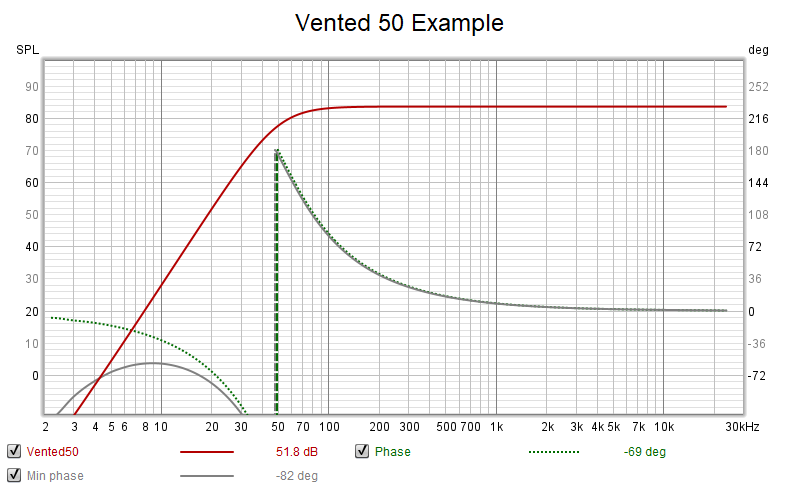
The group delay is not that high, this is not an extreme example.
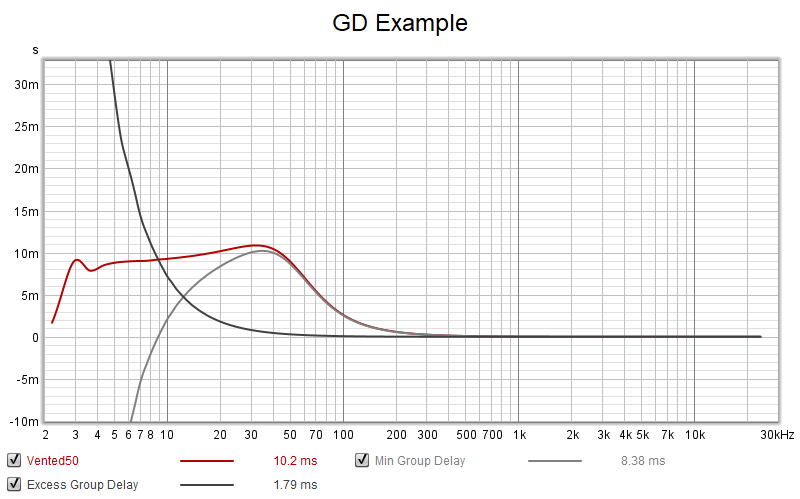
The rephase BR linearize is not minimum phase the magnitude is flat but the phase is the inverse of the BR box. This is what it looks like.
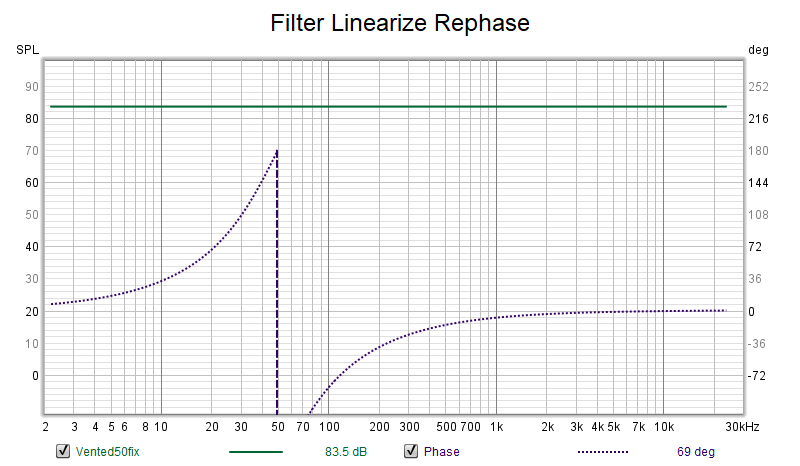
When you convolve the two together you are left with the 24dB slope but flat phase.
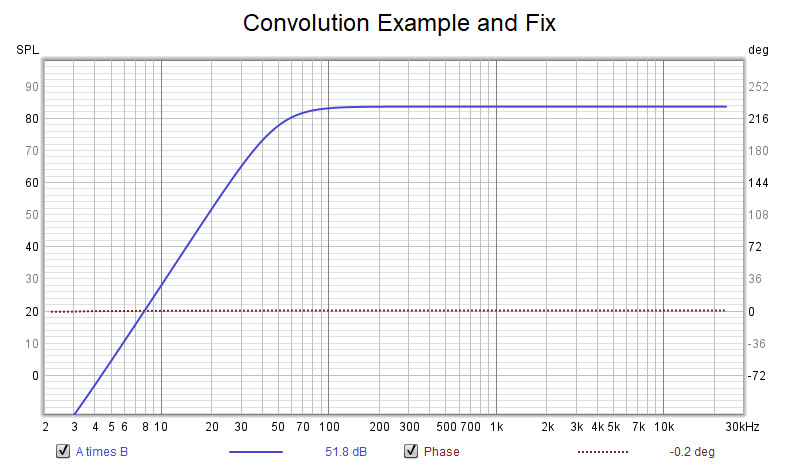
Phase comparison
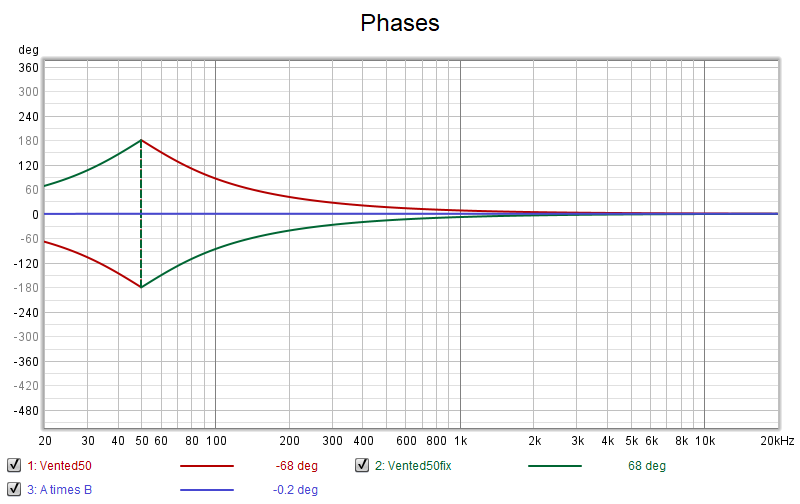
Your way smarter then me.....
you definitely made the case and it’s obvious and I do concede.
now do all that fancy scene work without any linearization, without any linear phase filters, and do the same with a sealed box. The sealed box will be the winning choice as far as overall phase and GD. Wouldn’t it be better to use rephase as a last resort instead of as a means to an end. Far less fir needed
I mean I get it what you’re putting down on paper theoretically is absolutely correct. but now how does it sound, I have some new argument saying that if you have enough taps and the know how to make an fir that would make a ported box the cats meow them by all means, I guess what I’m saying is my point was it’s a heck of a lot easier to get there with a sealed box
End the speaker is way more responsive with that airspring pushing against a compliance. It just (to me) has far better sound quality.
in or out of a car.
into the other person that wasn’t understanding what I meant by dropping the efficiency. I think I was fairly clear. Can you help put that in better terms? Maybe my terminology is just horrible 😛 🙂
It’s like if a sealed box produces a fairly flat response mostly flat let’s just say that iIt’s like if a sealed box produces a fairly flat response mostly flat let’s just assume that with most boundary interference, The ported box will have a peak.
The equalization needed to fix the peak eats up the efficiency. So you’re left with the same efficiency as the sealed box but with no subsonics, Port noise, resonance, and potentially Poor transient response.... how do I say that properly?
It's not my intention to appear smarter than you or anyone else only to try and help clear up a misunderstanding 🙂Okay,
Your way smarter then me.....
you definitely made the case and it’s obvious and I do concede.
Understanding how something works makes it much easier to work out why something sounds better than something else.I mean I get it what you’re putting down on paper theoretically is absolutely correct. but now how does it sound, I have some new argument saying that if you have enough taps and the know how to make an fir that would make a ported box the cats meow them by all means, I guess what I’m saying is my point was it’s a heck of a lot easier to get there with a sealed box
My clarification on what is happening in a box linearization has nothing to do with my own opinion, which I gave above, and said that overall I don't like it.
What is preferred, best or easiest is separate to describing "how" something works.
A sealed box or ported box tuned to have a similar initial rolloff to a sealed box does often match well with a generic room gain profile. This is why that sort of response is popular with manufacturers of hifi tower speakers. Placed in a statistically average position they won't sound boomy.into the other person that wasn’t understanding what I meant by dropping the efficiency. I think I was fairly clear. Can you help put that in better terms? Maybe my terminology is just horrible 😛 🙂
It’s like if a sealed box produces a fairly flat response mostly flat let’s just say that iIt’s like if a sealed box produces a fairly flat response mostly flat let’s just assume that with most boundary interference, The ported box will have a peak.
The equalization needed to fix the peak eats up the efficiency. So you’re left with the same efficiency as the sealed box but with no subsonics, Port noise, resonance, and potentially Poor transient response.... how do I say that properly?
For DIY we can go beyond statistically average and make it specific to our use case.
Equalization to reduce output doesn't eat efficiency, it is EQ to raise output where it doesn't already exist that costs power, heat and excursion.
Port placement and cabinet damping can make a huge difference to what comes out of a port, the transient response can be altered with EQ.
The only thing that a port cannot overcome is the explosion in excursion below it and the lack of response very low down. Whether this matters or if a high pass filter is enough depends on what the speaker is going to be used for and whether there are any other speakers in the system whose job it is to produce those frequencies.
I don't have many vented speakers and I have never tried to correct any of them so I do not have any experience on how that sounds. But I do have some experience that makes me think that it can be made to sound good because of what I do with a sealed box.
I use EQ to extend the response of my sealed box as low as possible before rolling it off at 24dB/oct F3 of 30Hz to protect it from too much excursion. So my speaker has a 24dB rolloff and minimum phase, the phase rises as the box rolls off and is not linearized. I really like the sound of this and I suspect that a vented box could be made to have the same response.
In Sean Olive's preference research the overriding factor in anechoic bass response that linked back to preference was how low the speaker went, LFX, low frequency extension. It doesn't mean that other factors are not important but making the response as low as possible is a big step in the right direction.
Okay you beat me...... :Banghead:It's not my intention to appear smarter than you or anyone else only to try and help clear up a misunderstanding 🙂
Understanding how something works makes it much easier to work out why something sounds better than something else.
My clarification on what is happening in a box linearization has nothing to do with my own opinion, which I gave above, and said that overall I don't like it.
What is preferred, best or easiest is separate to describing "how" something works.
A sealed box or ported box tuned to have a similar initial rolloff to a sealed box does often match well with a generic room gain profile. This is why that sort of response is popular with manufacturers of hifi tower speakers. Placed in a statistically average position they won't sound boomy.
For DIY we can go beyond statistically average and make it specific to our use case.
Equalization to reduce output doesn't eat efficiency, it is EQ to raise output where it doesn't already exist that costs power, heat and excursion.
Port placement and cabinet damping can make a huge difference to what comes out of a port, the transient response can be altered with EQ.
The only thing that a port cannot overcome is the explosion in excursion below it and the lack of response very low down. Whether this matters or if a high pass filter is enough depends on what the speaker is going to be used for and whether there are any other speakers in the system whose job it is to produce those frequencies.
I don't have many vented speakers and I have never tried to correct any of them so I do not have any experience on how that sounds. But I do have some experience that makes me think that it can be made to sound good because of what I do with a sealed box.
I use EQ to extend the response of my sealed box as low as possible before rolling it off at 24dB/oct F3 of 30Hz to protect it from too much excursion. So my speaker has a 24dB rolloff and minimum phase, the phase rises as the box rolls off and is not linearized. I really like the sound of this and I suspect that a vented box could be made to have the same response.
In Sean Olive's preference research the overriding factor in anechoic bass response that linked back to preference was how low the speaker went, LFX, low frequency extension. It doesn't mean that other factors are not important but making the response as low as possible is a big step in the right direction.
lol , I wish I was as talented as you so much sometimes. You guys are the best and this is the best thread ever !!!! Hands down!!! 🙂
Iterative REW / RePhase Workflow Method
To do this, use REW's EQ function, setup your desired target curve and instead of doing the entire N dB "Match Response to target" cut, do it across multiple passes. Select an incremental cut amount and generate the 1st set of PEQ's and save them using "Save filter settings to file" labeled as "left bank 1".
Then select the "Generate measurement from predicted" option below the "Save filter settings to file" to generate the new "predicted measurement".
Then select the EQ option on the newly generated "predicted measurement", lower the target curve by the chosen incremental amount and repeat the process naming the subsequent filters "left bank 2, left bank 3, ..., left bank N".
You can then load all N-incremental-banks into RePhase and get an aggregate filter more refined versus doing it in a single coarse pass in REW.
Good tip. Thx!
How i can run my custom exe file after generate rePhase file?
I want automaticly uploading filter file to my device...
I want automaticly uploading filter file to my device...
you would have to put the file in a target folder , the exe would have to always keep newest version on its command string....
Idk ..... very unusual automation.
how about just open the dsp program and simply drop it in yourself. It only takes about 3 sec out of your day. 🤖🔊🔉🔇🔈♥️
Idk ..... very unusual automation.
how about just open the dsp program and simply drop it in yourself. It only takes about 3 sec out of your day. 🤖🔊🔉🔇🔈♥️
- Home
- Design & Build
- Software Tools
- rePhase, a loudspeaker phase linearization, EQ and FIR filtering tool
